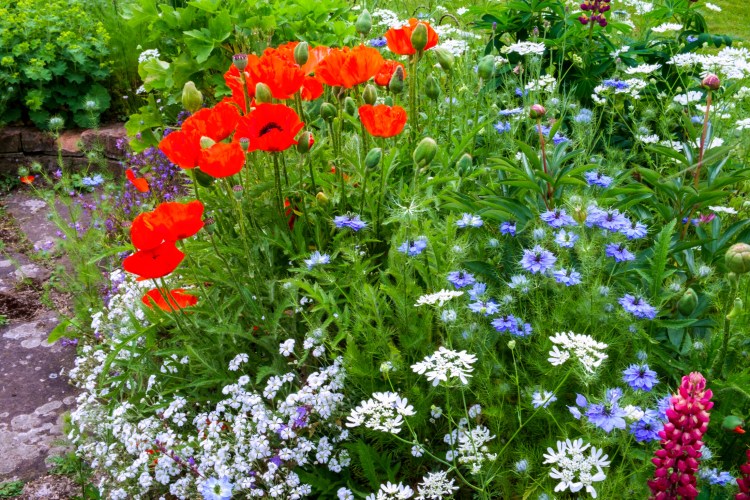When most people think of the ideal garden, they picture what is called an English cottage garden – a mass of colorful plants that fulfill a variety of purposes. It has flowers, of course, but also vegetables and herbs, little or no lawn and a few small trees but no 60-foot monsters that would provide too much shade.
English cottage gardens as we know them started in the late 1900s alongside the Arts and Crafts Movement, which was an alternative to the static forms and fussiness of the Victorian era. The cottage garden allows for more personal freedom and creativity.
The development of the cottage garden also was spurred, in part, by increased availability of plants from foreign countries. The gardeners definitely were not native-plant purists. If a plant bloomed reliably, for a long time and required little maintenance, it was encouraged – no matter what its parentage.
These gardens are a bit cluttered – but only a control freak would consider that a bad thing. The cottage garden doesn’t have the garden rooms, formed by hedges or something similar, that are the sign of much more formal gardens. With the cottage garden, everything flows together.
While it can include swaths of a single plant, cottage gardeners don’t worry much if a different flower pops up in the middle of the swath. Heck, if it’s blooming, it will work. If it’s a weed, it’s a pretty weed.
Annuals and perennials both are part of the cottage garden. It helps if the plants, especially annuals, self-seed. Sunflowers are popular in cottage gardens, and they will sprout from seeds that fall into the garden each year.
Other welcome self-seeders include poppies, bachelor’s button, cosmos, flax, rudbeckia and forget-me-nots. I know many people who consider forget-me-nots weeds, but I love them even though the abundant seeds stick to my gardening gloves and make my skin itch when I remove the spent plants in mid-summer.
Favored perennials include irises, daylilies, phlox, verbascum, peonies, mullein and hosta. Mostly if you like it and it’s not a lot of work, go for it.
Even though cottage gardens often welcome non-native plants, these gardens are gaining popularity for some environmental reasons, too.
First, more communities are banning weed killers and other pesticides – making it a lot easier to go with self-seeding plants, which would be killed off by weed killers. A bonus? Once they get established, these spready perennials will allow little room for weeds.
Second, since plants in a cottage garden are spaced together closely, mulch is unnecessary. Mulch itself isn’t necessarily bad for the environment, but gardens with just a few plants widely separated by yards of mulch – think shopping center strips and many an ultra-tidy suburban garden – form sterile environments, with few temptations for pollinators.
With food plants, it helps if they are pretty. Sections of Swiss chard are popular. Climbing vegetables such as peas, beans, various squash and cucumbers add visual as well as culinary appeal. Blueberries, raspberries and similar fruits are welcome, as are small fruiting trees such as dwarf apples, pears, peaches and cherries – not only for the fruits but for the attractive spring blossoms.
You can also plant peppers in various colors. I find that peppers are basically an upright plant that doesn’t use a lot of room, and you can have peppers in colors from yellow to purple.
The cottage garden needs paths – but nothing paved. Hard-packed soil is acceptable, as are bricks or stepping stones. Paths really just have to be places where nothing is actively growing.
The cottage garden also needs some climbing vines. Dutchman’s pipe is popular, as are climbing hydrangeas, roses, clematis and even hops. A climbing annual such as morning glory would add to a cottage garden. They come in white, pink, blues and red.
People growing an English cottage garden aren’t going to spend a lot of money on garden accessories. Old stumps, doors or windows taken from a house during a reconstruction project, rusting farm equipment and similar things work fine. And it helps if some of your climbing plants make their way up these decorations. Cottage gardens do best in full sun. Traditionally, in England they were in the front yard, where people strolling the streets could enjoy them. Americans put them anywhere they’ve got full sun.
They also prefer a lot of rich soil. But if enough compost is brought in, any garden can have that.
And you can bring a little bit of the Cotswolds to your own parcel of property in Maine.
Tom Atwell is a freelance writer gardening in Cape Elizabeth. He can be contacted at: tomatwell@me.com
Send questions/comments to the editors.



Success. Please wait for the page to reload. If the page does not reload within 5 seconds, please refresh the page.
Enter your email and password to access comments.
Hi, to comment on stories you must . This profile is in addition to your subscription and website login.
Already have a commenting profile? .
Invalid username/password.
Please check your email to confirm and complete your registration.
Only subscribers are eligible to post comments. Please subscribe or login first for digital access. Here’s why.
Use the form below to reset your password. When you've submitted your account email, we will send an email with a reset code.